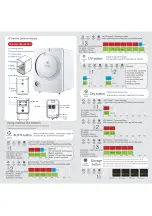
Lights:
Lights continuously “on” - Normal operation.
Slow flashing lights - Radio signal failure to the boat.
Two / three second blink - Hopper door release operated.
No lights - Transmitter set to “No lights” mode / or the boat is switched “off”.
Additional Operating Notes:
a. There is no mechanical rudder used on the boat. Its steering is achieved by altering the power
to the motors that drives the propellers.
b. The positions of the transmitter control joystick are directly proportional to the power to the
motors.
c. The boat possesses a very high degree of manoeuvrability, the maximum turning force being
when the throttle joystick is in the central position and the rudder joystick is at extreme right or
left.
d. With the lights (LEDs)
set to the “off” position there is no visual indication that the hopper door
has opened.
e. If it appears that the boat is becoming exhausted and may not make it back to you, then let the
boat drift for a while and the batteries will recover enough energy to make the return. You may
need to do this a couple of times. It is recommended that a bankside or solar charger be used
to top up the batteries after every trip.
f. If the propeller guard becomes blocked then this could affect the steering, so remove any
debris from the guards.
g. Should the boat take on any water, holding the boat with its stern facing down should drain the
water from the rear drain holes. This practice is recommended at all times.
h. The boat can be used in wind and rain. If the situation gets very difficult while the boat is still on
the water, it should be driven into or away from the wind, whichever is most convenient.
I. Do
NOT
use the boat in high winds and choppy conditions.
j. If the transmitter is turned “off” while the boat is still “on” the boat lights and pumps may operate
erratically, this is not good practice.
k. The motors may be operated out of water without fear of damage, unless fouled by a blockage,
which interferes with the propellers.
Never
try and remove anything that is fouling the propellers
with the batteries still connected.
l. There may be differences between the DVD and your boat. These changes have been made to
original system. These instructions supercede the DVD instructions (if different).
m. It is important that when the boat is not being charged that the supplied plastic cover is placed
over the charging socket. This will prevent anything entering the connector and will help prevent
corrosion.
n. Always pick the boat up gently as a fully loaded boat snatched up may cause excessive strain
on the handle and hull structure.
Batteries & Charging:
There are two mains powered chargers supplied with the boat. The boat charger is capable of
charging from fully discharged to fully charged in 18 - 20 hours. Under
NO
circumstances should the
batteries for the boat be fully discharged before charging as this can severely damage them. Boat
battery charging can take place at any time without any detrimental effect on their performance. If
the batteries are not used for some time they will need to be regularly charged (at least every 6-8
weeks) to keep them in peak condition.
Please always disconnect and remove the batteries
when the boat is in storage or being transported.
The transmitter (handset) charger will charge the transmitter in about 7-9 hours.
The transmitter batteries
DO
benefit from being completely discharged before recharged.
They can exhibit a “memory” and repeated charging and fully discharging should remove this
“memory” effect.
Do
NOT
under any6 circumstances use batteries other than 6 volt units as this will lead to
irreparable damage to your boat and will void the guarantee.
Both the boat and transmitter are charged while they are switched “off”.
If the boat is not going to be used for some months then every 6-8 weeks give the boat an overnight
charge to ensure the batteries remain fully charged.






















